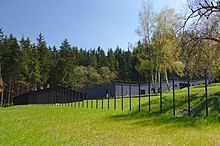Hodonín concentration camp
The Hodonín concentration camp in Hodonín u Kunštátu , then called the "Hodonin Gypsy Camp" , existed from 1942 to 1945 near Kunstadt north of Brno in the Protectorate of Bohemia and Moravia . The camp was part of the Porajmos during the National Socialism ; Like the Lety concentration camp , it was only one of several camps for Roma on the territory of the Protectorate.
history
Between 1929 and 1942 the site was used as a temporarily open forced labor camp. Starting in November 1939, the "moving around" of the homeless in the Protectorate of Bohemia and Moravia was prohibited. The construction of the camps took place according to the order of the Reich Protector Konstantin von Neurath of July 15, 1940, whereby the order 72/1939 of the government of Czechoslovakia of March 2, 1939 was adopted.
Those who had not settled down by the end of January 1940 were sent to labor camps that were set up for allegedly work-shy people. In the spring of 1940 the German occupiers in the Sudetenland had an exact list of all Roma living in the Protectorate with 6500 names drawn up. Another step towards persecuting the Roma was the establishment of labor camps in the summer of 1940 in Lety in South Bohemia and Hodonin in Moravia, where initially only men were imprisoned. However, this changed in the summer of 1942. From then on, entire families were imprisoned there on the pretext of minor legal violations.
Between 1942 and 1944, a total of 14 train transports were carried out by Roma from Lety and Hodonín to the Auschwitz concentration camp. Only around 10 percent of the Roma recorded in 1940 survived the Porajmos.
Around 1,300 Sinti and Roma were held in the concentration camp until they were deported and forced to work . Many members of this ethnic group died while in custody. Most of the prisoners were transported to the German extermination camps , especially the Auschwitz-Birkenau concentration camp , to be murdered by 1943 .
Establishment of a memorial
In the post-war period, the murder of Roma was a taboo subject in communist Czechoslovakia. In Hodonín, a Žalov holiday and leisure camp was set up on the site of the camp. Even after the topic became public in connection with this institution in the post-communist era, initially nothing changed about it. The Museum of Roma Culture started holding commemorative events in 1995. In 2009 the state bought the property in order to set up a worthy memorial to the Porajmos. The memorial was opened in 2017.
literature
- Guenter Lewy : Return not wanted - The persecution of the Gypsies in the Third Reich , Propylänen Verlag, Munich 2001, ISBN 3549071418 . (Original English: The Nazi persecution of the gypsies , Oxford University Press 2000, ISBN 0-19-512556-8 )
Individual evidence
- ↑ Thomas Kirschner: Disappeared Roma: Repressed history in Czech schools. In: Radio Prague from Jan. 18, 2007
Web links
- The Problem of the Former Roma Concentration Camps on the Territory of the Czech Republic . English Declaration by the Czech Committee for the Redress of the Romany Holocaust (VPORH-CRRH), February 2004
- First deportations and internment in assembly camps in 1938
Coordinates: 49 ° 30 ′ 27 ″ N , 16 ° 25 ′ 12 ″ E


